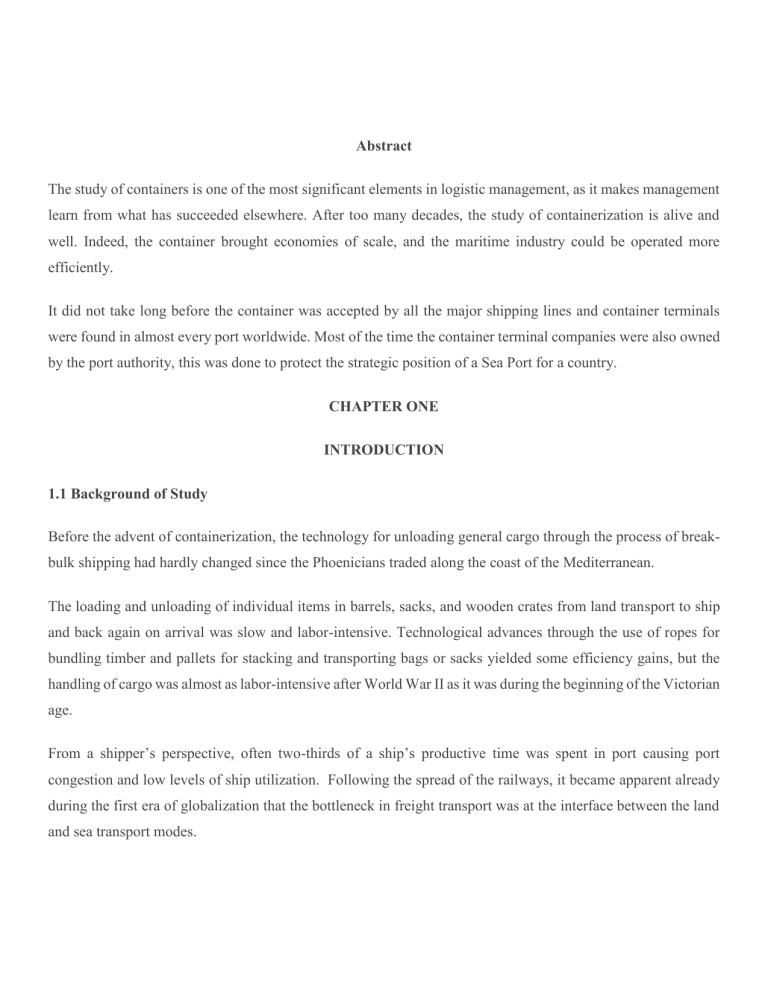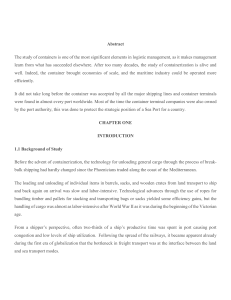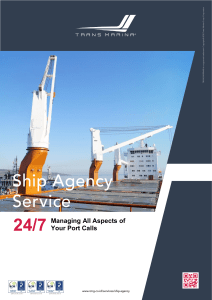
Abstract The study of containers is one of the most significant elements in logistic management, as it makes management learn from what has succeeded elsewhere. After too many decades, the study of containerization is alive and well. Indeed, the container brought economies of scale, and the maritime industry could be operated more efficiently. It did not take long before the container was accepted by all the major shipping lines and container terminals were found in almost every port worldwide. Most of the time the container terminal companies were also owned by the port authority, this was done to protect the strategic position of a Sea Port for a country. CHAPTER ONE INTRODUCTION 1.1 Background of Study Before the advent of containerization, the technology for unloading general cargo through the process of breakbulk shipping had hardly changed since the Phoenicians traded along the coast of the Mediterranean. The loading and unloading of individual items in barrels, sacks, and wooden crates from land transport to ship and back again on arrival was slow and labor-intensive. Technological advances through the use of ropes for bundling timber and pallets for stacking and transporting bags or sacks yielded some efficiency gains, but the handling of cargo was almost as labor-intensive after World War II as it was during the beginning of the Victorian age. From a shipper’s perspective, often two-thirds of a ship’s productive time was spent in port causing port congestion and low levels of ship utilization. Following the spread of the railways, it became apparent already during the first era of globalization that the bottleneck in freight transport was at the interface between the land and sea transport modes. Before World War II, US, British and French railway companies experimented with methods of sealing goods in different sizes and shapes of boxes before transporting them. However, the lack of specialized capital equipment like specialized cranes for loading and unloading combined with union resistance to changes in work practices at the docks delayed the development of container shipping until the mid-1950s. Containerization started as a private endeavor by the shipping lines. In the early stages, shipping lines had to bear most of the costs since many ports such as New York and London were reluctant to spend significant funds on ‘a new technology’ with uncertain returns at the time. Many shipping lines had to operate from small and formerly unknown ports and install their own cranes. The process was extremely expensive. After the container proved to be successful, ports warmed up to containerization and a race started among ports to attract the most shipping lines by building new terminals and providing the infrastructure to handle containers. Containerization required major technological changes in port facilities, which often led to the creation of new container ports. In many countries, port authorities fall under the administration of the government. Because of the high costs, careful planning and analysis had to be undertaken by governments to study the feasibility of containerization. In the UK, the government commissioned McKinsey (1967) to conduct a cost and benefit analysis before spending significant public funds on container port facilities. Five years later, McKinsey (1972) provided a quantitative assessment of the effects of containerization following the first five years after its adoption in the UK and Western Europe. 1.2 Problem Statement The issues of sustainability in maritime transport and logistics services have been considered in terms of environment, economy, and society. Recently, a substantial amount of research has been conducted on the improvement of energy efficiency and the use of cutting-edge technology. While there are many concerns about the ongoing US-China trade conflict and the proliferation of global protectionism, an in-depth research is lacking. Trade volume and maritime logistics services are closely linked, and sea freight prices have fluctuated widely since January 2018, as illustrated by the trend of the Baltic Dry Index (BDI). The BDI is a shipping cost index, which is used to be a leading indicator of future economic growth. 1.3 Objectives of the Research General objective The role played by containers in the transportation of goods by sea. Specific Objectives Safety and security Ease of transport Evaluate the effectiveness of sea transport Employment possibilities 1.4 Motivation What really motivated me to choose this topic are: 1. We want to help the AGIT SARL during their importation and exportation of goods through containers. 2. We wish to tell the Human Resource Department to allow people to use and understand the use of containers during their importation and exportation of goods. 1.5 Goal The main goal of this study is to propose the best strategies for achieving a 25% performance improvement through effective environment, economy and society in the Sea Port, applying logistics techniques within 5 business cycles. 1.6 Research Questions 1. How can the containers give the advantages during their transportations¬¬? 2. Why containers are very important¬¬? 3. How can we develop the productivity of used containers in the sea port? 4. Can the used of containers facilitate the easily transportation of goods from one place to another? 1.7 Hypothesis Ho. The best strategies for achieving a 25% performance improvement through effective environment, economy and society in sea port, airport applying logistics techniques within 5 business cycles cannot succeed. H1. The best strategies for achieving a 25% performance improvement through effective environment, economy and society in sea port, airport applying logistics techniques within 5 business cycles can succeed.

